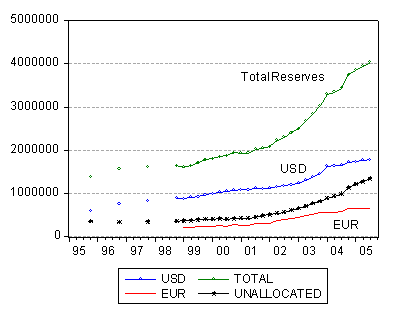New IMF quarterly data on central bank reserve holdings
Starting with the 2005 Annual Report, the IMF began reporting (year-end) central bank reserve holdings on a different basis than in previous Reports. Most significantly, it no longer undertook estimation of the currency composition of reserves. This change had a large impact upon the figures for the less developed country central bank holding figures, and hence to a lesser extent for total holdings.
Today, the IMF reported quarterly data on these series, going back to 1995. Below is a time-series graph of “Total”, “USD” and “EUR” and “Unallocated” holdings for all (industrial country and less developed country) central bank holdings. “Unallocated” (the black line) denotes reserve holdings in currencies unreported by the central banks.

All the data are reported, and documentation provided, at:
Currency Composition of Official Foreign Exchange Reserves (COFER)
One observation: While the dollar reserves series has plateaued since the beginning of 2004, the “Unallocated” series continues to rise. One can only conjecture on what is in this series, although the suspicion is that much of it is in dollars.
I found the relative amt reported as “unallocated” to be somewhat troubling. People at my employers might get fired for much less than lumping so much in a vague bucket.
menzie — thanks for the heads up on this data series. from eyeballing the data, it looks like China’s reserves are among those that are unallocated. add in the fact that the saudis use a very narrow definition of reserves, and thus show a very small increase in reserves this year (the non monetary external assets of the saudi central bank by contrast are increasing very rapidly) and the IMF data misses some quasi reserve accumulation, and seems to provide less and less useful information about the currency composition of the marginal increase in reserves.
Brad Setser: Excellent point, as usual. The People’s Bank of China is indeed, to the best of my knowledge, one of the central banks that does not report the composition of reserves. My guess is that a large chunk of the “unallocated” category is attributable to China.
For sure, these numbers do not capture the entire extent of reserve accumulation. It’s probably a good idea to remember that reserve accumulation here pertains to that undertaken by central banks; accumulation undertaken by other government or quasi-governmental entities are not typically covered. In some cases, they shouldn’t be included. In others, it might be argued that they should.
try again: I agree it’s disquieting that there is such a large “unallocated” component. However, previously unsuccessful attempts to precisely “estimate” currency shares provide a cautionary note. I think the Fund is much better off being explicit about the limits of our knowledge, and allow others to try to infer using their own methods the likely shares.
menzie — do you know the convention when it comes to reporting two components of central reserves:
a) government (as in Treasury) fx deposits with the central bank, call it Treasury fiscal reserves
b) bank mandatory reserves on the banking system’s fx deposits, with the reserve requirement met by depositing fx at the central bank
in both cases, the central bank has an asset (the fx, which it places somewhere) and an fx liability, whether to the treasury or to the domestic banking system. not sure if there is a standard for reporting either … a large share of the increase in total assets of the saudi monetary authority seems to reflect the saudi treasury’s fiscal surplus. To me, this seems like an indirect way of supporting the saudi peg. rather than bringing converting the $ from oil exports into local currency, the government just holds the $ on deposit. otherwise, it is not obvious to me how SAMA can defend a $ peg with so much less formal reserve accumulation than either in China or Russia.
it certainly seems that non-resident fx deposits placed with the central bank are commonly included as reserves — see Turkey as well as India/ Pakistan. where is my imf BOP manuel …
“What’s out there?”
This can be nerve-racking.
Brad Setser: The COFER website indicates the following:
“Foreign exchange reserves in COFER consist of the monetary authorities’ claims on nonresidents in the form of: foreign banknotes, bank deposits,
treasury bills, short- and long-term government securities, and other claims usable in the event of balance of payments needs.”
I don’t have the BoP Manual either; however the IMF 2005 Annual Report appendix I on Reserve Holdings seems to indicate that the data is based on IFS data. The IFS description of the international liquidity section says that the data pertain the “monetary authorities”, parenthetically described as: “(Monetary authorities comprise central banks and, to the extent that they perform monetary authorities’ functions, currency boards, exchange stabilization funds, and treasuries.)”
This description indicates that the IMF seems to have some latitude for judging what goes in and what doesn’t go into the reserves numbers. In order to get the answer to your question, we’d probably have to contact the relevant person in the Statistics Department at the Fund.
menzie — thx